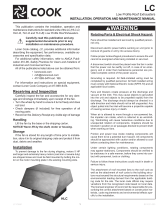
Upblast Centrifugal Roof Exhaust 3
Indoor
The ideal environment for the storage of fans and
accessories is indoors, above grade, in a low humidity
atmosphere which is sealed to prevent the entry of
blowing dust, rain or snow. Temperatures should be
evenly maintained between 30° to 110°F (-1° to 43°C)
(wide temperature swings may cause condensation
and “sweating” of metal parts). All accessories must be
stored indoors in a clean, dry atmosphere. Remove any
accumulations of dirt, water, ice or snow and wipe dry
before moving to indoor storage. To avoid “sweating” of
metal parts, allow cold parts to reach room temperature.
To dry parts and packages, use a portable electric
heater to get rid of any moisture buildup. Leave
coverings loose to permit air circulation and to allow for
periodic inspection.
The unit should be stored at least 3-1/2 inches (89 mm)
off the floor on wooden blocks covered with moisture
proof paper or polyethylene sheathing. Aisles between
parts and along all walls should be provided to permit
air circulation and space for inspection.
Outdoor
Fans designed for outdoor applications may be stored
outdoors, if absolutely necessary. Roads or aisles for
portable cranes and hauling equipment are needed.
The fan should be placed on a level surface to prevent
water from leaking into the fan. The fan should be
elevated on an adequate number of wooden blocks so
that it is above water and snow levels and has enough
blocking to prevent it from settling into soft ground.
Locate parts far enough apart to permit air circulation,
sunlight and space for periodic inspection. To minimize
water accumulation, place all fan parts on blocking
supports so that rain water will run off.
Do not cover parts with plastic film or tarps as these
cause condensation of moisture from the air passing
through heating and cooling cycles.
Fan wheels should be blocked to prevent spinning
caused by strong winds.
Inspection and Maintenance
During Storage
While in storage, inspect fans once per month. Keep a
record of inspection and maintenance performed.
If moisture or dirt accumulations are found on parts,
the source should be located and eliminated. At each
inspection, rotate the wheel by hand ten to fifteen
revolutions to distribute lubricant in motor. If paint
deterioration begins, consideration should be given to
touch-up or repainting. Fans with special coatings may
require special techniques for touch-up or repair.
Machined parts coated with rust preventive should be
restored to good condition promptly if signs of rust
occur. Immediately remove the original rust preventive
coating with petroleum solvent and clean with lint-free
cloths. Polish any remaining rust from surface with
crocus cloth or fine emery paper and oil. Do not destroy
IMPORTANT
Installation, troubleshooting and parts replacement
are to be performed only by qualified personnel.
Consult and follow all applicable national, state and
local codes. They will supercede this document.
the continuity of the surfaces. Thoroughly wipe clean
with Tectyl
®
506 (Ashland Inc.) or the equivalent. For
hard to reach internal surfaces or for occasional use,
consider using Tectyl
®
511M Rust Preventive, WD-40®
or the equivalent.
Removing From Storage
As fans are removed from storage to be installed in
their final location, they should be protected and
maintained in a similar fashion until the fan equipment
goes into operation.
Dimensional Data
Direct Drive
Model Size Curb Cap Damper
Roof/Wall
Opening
Wall Opening
with a curb
through wall
**Approx.
Weight
060, 070 17 (432) 8 (203) 10
1
⁄2 (267) 17 (432) 29 (13)
080, 090, 095 19 (483) 10 (254) 12
1
⁄2 (318) 19 (483) 40 (18)
099, 100, 101*,
120, 121*, 130,
131*
19 (483) 12 (305) 14
1
⁄2 (368) 19 (483) 67 (30)
140, 141*, 160,
161*
22 (559) 16 (406) 18
1
⁄2 (470) 22 (559) 90 (41)
180, 200,
200HP
30 (762) 18 (457) 20
1
⁄2 (521) 30 (762) 142 (64)
240, 240HP 34 (864) 24 (610) 26
1
⁄2 (673) N/A 175 (79)
300, 300HP 40 (1016) 30 (762) 32
1
⁄2 (826) N/A 313 (142)
Belt Drive
Model Size Curb Cap
Shaft
Bearings
Damper
Roof/Wall
Opening
Wall
Opening
with a curb
through
wall
**Approx.
Weight
099, 100, 101*,
100HP, 101HP*,
120, 121*, 130,
131*
19 (483)
3
⁄4 (19) 12 (305) 14
1
⁄2 (368) 19 (483) 66 (30)
140, 141*,
140HP, 141HP*,
160, 161*,
160HP, 161HP*
22 (559)
3
⁄4 (19) 16 (406) 18
1
⁄2 (470) 22 (559) 87 (39)
160XP, 161XP* 22 (559) 1 (25) 16 (406) 18
1
⁄2 (470) 22 (559) 87 (39)
180 30 (762)
3
⁄4 (19) 18 (457) 20
1
⁄2 (521) 30 (762) 126 (57)
180HP 30 (762) 1 (25) 18 (457) 20
1
⁄2 (521) 30 (762) 126 (57)
200 30 (762)
3
⁄4 (19) 18 (457) 20
1
⁄2 (521) 30 (762) 142 (64)
200HP 30 (762) 1 (25) 18 (457) 20
1
⁄2 (521) 30 (762) 142 (64)
220, 220HP, 240,
240HP, 240XP
34 (864) 1 (25) 24 (610) 26
1
⁄2 (673) 34 (864) 175 (79)
300, 300HP,
300XP
40 (1016) 1 (25) 30 (762) 32½ (826) 40 (1016) 313 (142)
360, 360HP,
360XP
46 (1168) 1
1
⁄4 (32) 36 (914) 38
1
⁄2 (978) N/A 440 (200)
420 52 (1321) 1
1
⁄4 (32) 42 (1067) 44
1
⁄2 (1130) N/A 578 (262)
480 58 (1473) 1
1
⁄2 (38) 48 (1219) 50
1
⁄2 (1283) N/A 675 (306)
• All dimensions are in inches (millimeters).
* Previous size, no physical product change with new size
** Approximate weight shown in lbs. (kg.) is the largest cataloged open
drip proof motor.
• “Curb Cap” is the inside dimension of the curb cap
• The roof curb should be 1½ in. (38 mm) less than the curb cap to allow for
roofing and flashing.
• Roof/wall opening is a square dimension.














